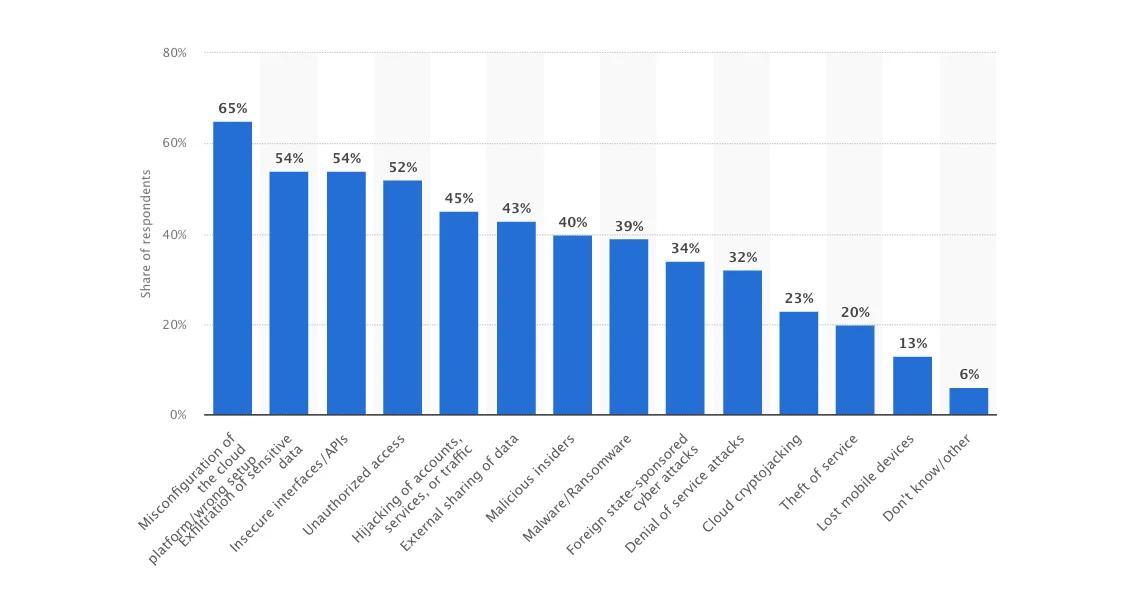Cloud Security Best Practices: An In-Depth Expert Guide
- DevOps
- November 27, 2023
Cloud security is crucial for businesses as the cloud stores sensitive user data, financial records, and intellectual property. Various aspects are at stake, including business continuity, reputation, customer loyalty, compliance, and more. Hence, ensuring cloud security is paramount for businesses. This blog not only discusses some of the critical risks and reasons for ensuring cloud security but also elaborates on cloud security best practices that you can consider to eliminate these risks.
Access to the cloud has transformed the way of business processes. Around 94% of global companies utilize cloud computing in their operations.
While the cloud is advantageous in several ways, it has some risks also, which companies must analyze completely before distributing assets there. With current technological attacks and violations, maintaining security has become a concern for global businesses.
To help you avoid becoming the victim of security breach, here, we have created a comprehensive guide that gives insights on enhancing cloud computing security. Throughout this blog, you will explore potential challenges, benefits, and cloud security best practices.
So, let’s get started with its brief definition!
What is Cloud Security?
Cloud security includes processes, controls, policies, and technologies integrated to safeguard your cloud-based infrastructure, data, and systems. It’s a shared responsibility between the user and the cloud service provider.
To protect your consumer privacy, you need to practice cloud computing security best practices. It shields your data and you from the legal, financial, and reputational complications of data loss and breaches.
Many companies employ cloud services or infrastructure whether in the form of SaaS (Software as a Service), IaaS (Infrastructure as a Service), or PaaS (Platform as a Service). Here,every deployment model has its own critical security considerations.
Read also: IaaS vs PaaS vs SaaS: Picking the Best Cloud Computing Service Model
Security Risks of Cloud Computing
When you are using cloud computing for business, security is the prime concern. You may experience some risks that can affect the reputation and profit of your business. While shifting to the cloud, you may find some new risks, but it does not imply that cloud computing is completely risky.
You may access some convenient security resources and tools to reduce the risks. Let’s have a look at the most common security risks of cloud computing:
Data Loss
Although a secure cloud service does not reduce every data loss threat, it provides simple and affordable solutions for disaster restoration and backup. Compared to on-premise solutions, cloud environments can offer extra flexibility for disaster recovery and store data on numerous cloud data centers.
Insider Threats
The worst enemy of your organization often comes from inside. This threat could be an error or malicious actor. Insider threats can also happen due to some other cloud security risks, incorporating credential theft, data violations, and misconfigurations.
Otherwise, people can get susceptible to some socially engineered attacks and phishing attacks that cause data compromise. They could be transferring business data from company clouds to shadow cloud formats on their personal gadgets.
Compliance Breaches
With the growing regulatory control, you will possibly require complying with some rigid compliance needs. If you are careless while moving to the cloud, you may experience the risk of compliance breaches. Your organization should know some regulations like where your data is located, the people who have its access, how it can be processed, and how to shield it.
Moreover, your cloud provider holds some compliance credential. An irresponsible data transfer to the cloud or moving to the incorrect provider can put your company in a non-compliance state. It introduces some financial and legal issues.
Credentiality Theft
It is an extremely popular attack strategy as anybody with access to your credentials can access the cloud environment easily. Although some credential thefts involve key-logging malware, a drive-by threat can easily find the username and password written on the paper. You cannot detect unnecessary logins with genuine credentials.
Contractual Violations
Your contractual partnerships should incorporate some limitations on how the shared data is stored and used and who can access it. If your employees move restricted data carelessly into cloud service with no authorization, it could cause a contractual breach that may cause legal action.
Thereby, ensure to read the terms and conditions of your cloud provider. In case you are authorized to move data to the cloud, some providers incorporate the right to share all data uploaded into their cloud infrastructure. Hence, if you ignore it, it could violate a non-disclosure agreement (NDA) accidentally.
Data Breaches
It is the worst nightmare for any company. It causes data compromise or loss of intellectual property, client data, and workers’ PII (Personally Identifiable Information). As a result, it ruins the company’s reputation and causes financial loss.
Moreover, your organization may fail to comply with the industry or government data privacy standards mentioned in its contracts.
Misconfiguration of Cloud Services
It is another potent cloud security risk with a range of complex services and increasing problems. Misconfiguration of cloud services can lead to data manipulation, disclosure, or destruction entirely.
The reason for this problem incorporates keeping primary access and security management settings for highly sophisticated data. Others can add incorrect access management, providing disfigured data access and unauthorized individuals access where confidential information is open with no requirement for authorization.
Cloud Account Hijacking
It is a malicious holding of cloud accounts. Sometimes, hackers, hijackers, and threat actors follow extremely privileged accounts or cloud service subscriptions to steal someone’s identity.
In this particular case, thieves use exposed credentials, usually an email, to hold the cloud account. After the hijacking, thieves can manipulate the apps and data in the cloud.
Insecure APIs
You may employ an API to execute control while operating systems in a cloud infrastructure. Every API created into your mobile or web apps can give access externally by clients or internally by employees.
However, external-facing APIs can bring a cloud security risk. An unstable API offers unauthorized access to cyber criminals who seek to steal and manipulate data and cloud services.
Insufficiency of Cloud Security Methods and Architecture
You can avoid this cloud security risk. While moving data and systems to the cloud, many companies become active before all security strategies and systems start to safeguard their infrastructure. Ensure to execute a security method and infrastructure made for the cloud to protect your data and systems.
Social Engineering
It’s a kind of cloud security breach type where an attacker can trick an employee to avail access to a cloud environment. Apart from that, you will come across other social engineering techniques, and phishing is among the one.
Phishing involves the kind of email content that can make users click on it and disclose their sensitive information to the malicious actor. It can lure users by asking for changing credentials or downloading files. If they do such, then consider the account compromised.
Shadow IT
In many cases, employees from your organization access information, install foreign software and do much more without the approval of the IT security team. Because of this action, this unapproved software can create security challenges, putting the entire business IT infrastructure vulnerable to cybersecurity attacks.
This vulnerability can enable cybercriminals to delete or alter sensitive business data. They can even misuse this data for their ulterior motives.
So, having a cloud system onboard, you can face these concerns, which can lead to thinking about employing security practices. But what benefits can cloud security practices provide to you? The next section is all about that.
Why Do You Need Cloud Security?
With 46% of business IT leaders identifying external actors, such as hackers, as the most significant security threat to their cloud data, it is evident why robust security measures are essential to protect sensitive information. In 2023, 39% of businesses experienced a data breach in their cloud environment, an increase from 35% in 2022.
According to a survey, 65% of global respondents considered misconfiguration of the cloud platform as the biggest security threat in public clouds.

In one market study, Gartner predicts that around 75% of organizations globally will go through digital transformation with a cloud by 2026. Hence, by 2024, the overall spending on cloud infrastructure will increase to 724.566 billion, which includes investment in SaaS, PaaS, IaaS, BPaaS, and DaaS.
Although cloud technology has become extremely popular, many companies are still concerned about its security.
Here are the reasons why cloud computing security is highly important:
Protection Against Data Security Breaches
When it comes to running an app on a hybrid or public cloud, you will depend on a third party for your data handling. Thereby, you cannot control the data security any more. Hence, you should ensure that the cloud service provider understands his responsibility.
However, being a client, you should always verify the data security even if your cloud computing service provider makes sure top-notch security.
Better Remote Work Management
Remote work gives you access to employ people from across the world. However, this type of arrangement has some security risks as well. Since you will use your gadgets, your data may get disclosed to phishing and malware attacks. If malware enters through these devices into the cloud system, your company can be at stake.
Disaster Restoration
Natural disasters like fire or flooding are unpredictable and uncontrollable. So, if your data is not safeguarded and secured, you may experience data loss. Moreover, your clients may lose their confidence in your company, which, in turn, can become harmful for your business.
Create Data Access Levels
Unexpected data leaks can put your business integrity in jeopardy and encourage your competitors. Restricting data access just to the employees who require it can hinder mistakes that cause data leaks.
Comply with Data Protection Regulations
Data protection rules were accumulated to ensure the security and integrity of client data. If you store your client data on the cloud, you need to ensure its security, particularly if your company belongs to a well-regulated industry like legal, banking, insurance, or finance. A data violation can spoil your reputation and brand, as outsider parties will consider you responsible.
All-time Visibility
When employing cloud security best practices and cloud monitoring tools, such can give you 24×7 visibility across your cloud ecosystem. This continuous visibility gives you the control to take command of your cloud network layer and provide vigilant cloud computing security actions against potential threats.
Regular Security Updates and Patches
When you take cloud security seriously, you also take regular assessment and patch-up of your cloud layer seriously. With technological advancements, you also need to keep your cloud ecosystem up-to-date with regular security updates and patches. So it can be immune from the engineered and latest attacks.
14 Cloud Security Best Practices
Many companies operate their business systems in the cloud on the three prime cloud computing service providers – Amazon Web Services (AWS), Microsoft Azure, and Google Cloud Platform (GCP). Every cloud provider offers a large ecosystem of cloud services and infrastructure.
Though embedded with many default cloud security parameters, these cloud platforms can get into the risk of cloud attacks. Hence, these top cloud service providers offer best-in-class security tools and practices.
After getting all these, your first step would be to identify security risks and fix them. If you know what kinds of risks can threaten your cloud security, you can take some steps to reduce these risks.
So, here’s the list of cloud security best practices to help you deal with concerning cloud computing security challenges:
1. Develop a Comprehensive Cloud Security Strategy
When you adopt a cloud platform, creating a cloud utilization and security strategy is the foremost thing you should do. Because with time, technologies will evolve, and cyber criminals will refine their attacks. Hence, to protect your cloud platform from evolving cyber threats, you must create a smart cloud security strategy that can cover all potential loopholes.
So, when creating your cloud security strategy, you must:
- Conduct a thorough cloud environment assessment
- Clearly define security goals
- Understand shared security responsibilities
- Implement cloud access controls
- Adopt cloud security best practices
- Develop a cloud backup and disaster recovery plan
- Establish cloud governance strategies and policies
2. Select a Reliable Cloud Service Provider(CSP)
You can team up with a reliable cloud service provider who offers in-built cloud computing security protocols and follows the highest levels of the industry-best practices. While selecting your cloud service provider, you must check their certifications and security compliances.
You can also assess your cloud service provider with the following questions:
- What protocol do they follow for suspected security incidents?
- What would be their disaster recovery plan?
- What’s their strategy to protect the multi-tenant cloud ecosystem?
- To what extent can they provide their cloud support?
- What support did they provide for their recent penetration test results?
- What types of cloud access control do they require?
- What types of cloud compliance requirements can they meet?
3. Foster Open Communication with Your CSP
When you team up with a cloud service provider, it becomes a shared responsibility partnership for security applications. For better information, this shared responsibility includes finding security areas to harden and distributing security jobs for you and your cloud security service provider.
Also, to maintain the harmony of this partnership, you must make sure of the clarity and transparency in your partnership of shared accountability.
4. Segment Your Cloud Network
Cloud network segmentation is the best solution you can employ to easily manage it and limit its impact from potential breaches and unauthorized lateral movement.
But how? By isolating cloud instances, containers, apps, and more, using a zone approach or creating virtual private clouds. And it is even more beneficial when you are managing multi-tenant environments.
5. Empower Your Users Through Training
Users are your primary protection system in secure cloud computing. Their security practices and knowledge can either expose your system to cyber-attacks or protect it.
Hence, ensure to train all users like employees and stakeholders who have the system access in the secure cloud practices. Teach them how to recognize phishing emails, malware, and the risks of unstable practices. Also, consider industry-specific training and certification for more advanced users like administrators who are involved directly in executing cloud computing security.
6. Maintain Your Cloud Services’ Visibility
You cannot secure your cloud platform from something you don’t know or have no visibility around. Using many cloud services across different locations and providers can reduce your cloud environment’s visibility.
Hence, ensure to execute a cloud security solution that maintains visibility across the cloud ecosystem. After that, you can execute granular security strategies to reduce many security risks.
7. Enforce Strong Password Policies
No matter what service you are using, a strong password security policy is always the best practice. This policy is necessary to prevent unnecessary access. All passwords must need a lower-case letter, an upper-case letter, a symbol, or a digit, and it should be of at least 14 characters. Make sure the users update their passwords every 3 months.
This password policy will prevent users from creating easy passwords across many gadgets and protect against malicious attacks. You can also enforce and must enforce multi-factor authentication as an extra layer of cloud security best practices.
8. Secure Your Cloud Endpoints
Many users access cloud services through website browsers. Hence, you should launch advanced client-side security for updating your browsers and protecting them from vulnerabilities.
Moreover, you must have an endpoint security solution to safeguard your end-user devices. Search for a solution that incorporates internet security tools, antivirus, intrusion detection tools, mobile device security, and firewalls.
9. Prioritize Data Encryption
Your data may get susceptible to higher risk while deploying it between the cloud service and your network. So, consider encrypting your data – both at rest and in transactions to ensure its security from every angle.
10. Implement Granular Access Controls
This cloud security best practice helps you deal with the users who try to access your cloud. Begin with zero trust; just provide users access to the data and systems they need.
To reduce complicacy while enforcing policies, form well-defined groups with specific roles to consider access to selected resources. Furthermore, you can add users straight to groups instead of tailoring access for each and every user.
11. Utilize a CASB (Cloud Access Security Broker)
CASB is becoming the main tool to execute cloud security best practices. This software sitting between you and the cloud service provider maximizes security controls in the cloud.
Moreover, a CASB provides an advanced cloud computing security toolset to implement data security policies, offer visibility of the cloud ecosystem, keep up with compliance, and enforce threat identification and protection.
12. Conduct Regular Vulnerability Assessment and Management
Precisely, cloud vulnerability testing and management is the continuous process of analyzing, identifying, reporting, and mitigating cloud security risks.
To do this task finely, you must know the types of cloud vulnerabilities:
- Misconfigurations
- Non-compliance
- Cloud accessibility loopholes
- Vulnerable APIs
So, to proactively manage your cloud vulnerability, as a cloud security best practice, you should conduct comprehensive vulnerability scanning, regular cloud penetration testing, and vulnerability prioritization to better harden your cloud ecosystem.
You can even utilize AI solutions for vulnerability management, which is known as threat intelligence to automatically conduct vulnerability assessment, report them, and even fix the basic ones.
13. Establish a Disaster Recovery (DR) Plan
Natural disasters (like floods, hurricanes, earthquakes, etc.) are uncertain and can show up at any time and destroy your years of effort in just a fraction of time. Hence, to avoid the consequences of natural and even human-induced disasters (like cyberattacks and human errors), having a disaster recovery strategy in place can help you deal with the aftermath of significant disruptive events.
But what does this disaster recovery include? So, your disaster recovery plan may include data backup in more than one connected yet acting as an independent site, data redundancy and failover, communication plan, drills, incident response, and business continuity plan.
14. Maintain Compliance with Regulations
There are different compliances for each industry. For example, HIPAA for healthcare organizations, PCI-DSS for financial data security, GDPR for general user data protection, and more. And you must ensure that your cloud ecosystem is compliant according to such requirements.
These compliances provide you with best practices to harden your IT network and avoid becoming the victim of cyberattacks. Because failing to do so can cost you handsome penalty charges.
Therefore, you must plan to comply with your industry regulation standards no matter what.

How Can MindInventory Assist You In Tightening Your Cloud Security?
You need a rock-solid security strategy if you are moving to the cloud. Hence, make sure to choose the cloud service provider carefully. Any time a hacker can attack your business. So, ensure to implement the aforesaid cloud computing security best practices to enhance the security of your cloud computing system.
You can even hire a cloud service provider, like MindInventory, to work dedicatedly to take care of your cloud ecosystem and its security. So, are you someone looking for end-to-end cloud services? Let us know your requirements and get a world-class cloud solution.
FAQs on Cloud Security
If you see there are many misconceptions revolving around cloud security, and some of them include that the cloud is insecure, your cloud service provider is responsible for everything, thinking data backups are automatic and infallible, neglecting the importance of identity and access management (IAM), irregular in updating security settings, and more.
The tools and technologies for cloud security come within your cloud bundle. But your approaches play an essential in enhancing your cloud computing security, which includes IAM, encryption, virtual private cloud (VPC), network security, security information and event management (SIEM), cloud access security broker (CASB), Data Loss Prevention tools, Cloud Security Posture Management (CSPM) tools, serverless security, threat intelligence, etc.
The cost of cloud computing security varies depending on the complexity of your requirements, typically ranging from $2,000 to over $10,000 or more per month. Several factors influence this cost, including the size and complexity of your cloud infrastructure, the specific cloud security services you choose, your cloud provider’s pricing model, the sensitivity of your data, and more.













